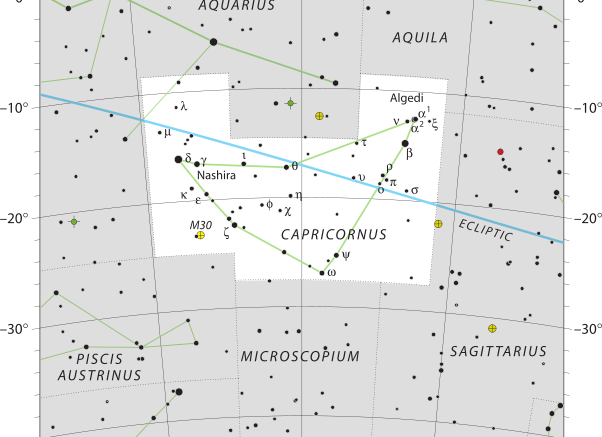Located in the Southern Hemisphere, Capricornus represents a creature that is a blend of fish and goat; with the name in Latin translating to “goat horn.” Capricornus is among the faintest constellations in the sky, and is just brighter than the constellation Cancer for reference. Capricornus is the 40th largest constellation in the sky, measuring 414 square degrees. The area of the sky that the constellation is in, all have water related names.
Capricornus is home to several notable stars, as well as to the famous globular cluster Messier 30.
| Applicable Information | |
| Visibility In Pacific Northwest | April to December |
| Best Times To View | September |
| Right Ascension | 20h 06m 46.4871s to 21h 59m 04.8693s |
| Declination | −8.4043999° to −27.6914144° |
| Area | 414 square degrees |
| Main Stars | 9, 13, 23 |
| Brightest Object | δ Cap |
| Meteor showers | Alpha Capricornids |
| Messier objects | 1 |
| Neighboring Constellations | Aquarius, Aquila, Sagittarius, Microscopium, Piscis Austrinus |
Mythology
Despite being faint, Capricornus has one of the oldest mythologies, as the representation of a hybrid goat and fish has been synonymous since the Middle Bronze Age. This started with the Babylonians.
Greek mythology sometimes identifies Capricornus as Amalthea, the goat that suckled the infant Zeus after his mother, Rhea, saved him from being devoured by his father, Cronos. Amalthea’s broken horn was transformed into the cornucopia or “horn of plenty”.
Capricornus is also sometimes identified as Pan, the god with a goat’s horns and legs, who saved himself from the monster Typhon by giving himself a fish’s tail and diving into a river.
History
The first depictions of the constellation was from around the 21st century BCE, but was explicitly recorded in the Babylonian star catalogues before 1000 BCE.
In September 1846, Johann Galle discovered the planet Neptune in what was the constellation Capricornus.
Stars
Capricornus is a faint constellation, as 1 star is above magnitude 3, which is the magnitude 3.6 alpha star.
The brightest star in Capricornus is δ Capricorni, also called Deneb Algedi, has a magnitude of 2.9.
Several galaxies and star clusters are contained within the constellation.
M30, otherwise known as NGC 7099, is a centrally-condensed globular cluster of magnitude 7.5 has chains of stars extending to the north that are resolvable in small amateur telescopes.
Make sure to check out other articles on the site, including a brief introduction to constellations, other constellation articles, and more!

Be the first to comment on "Capricornus"